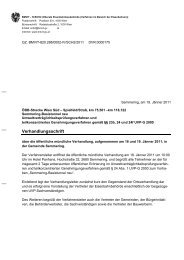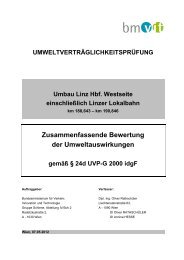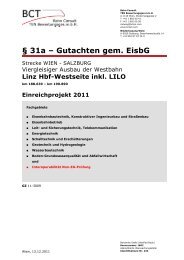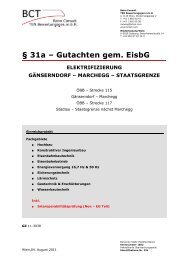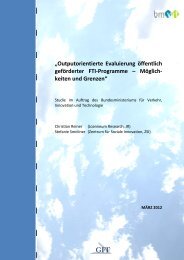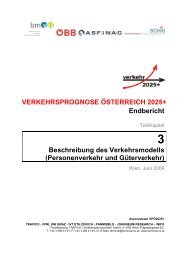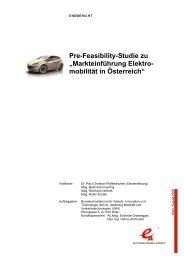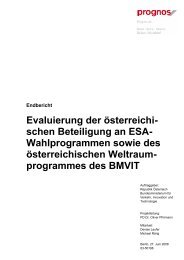Schriftenreihe .;technologiekompetenz Verkehr in
Schriftenreihe .;technologiekompetenz Verkehr in
Schriftenreihe .;technologiekompetenz Verkehr in
You also want an ePaper? Increase the reach of your titles
YUMPU automatically turns print PDFs into web optimized ePapers that Google loves.
LITHIUM-ION BATTERY (LI-ION)<br />
The Li-ion battery is the latest advance <strong>in</strong> battery technology and<br />
is already established and widespread <strong>in</strong> the field of portable<br />
devices. Many experts see it as a highly promis<strong>in</strong>g candidate <strong>in</strong><br />
power<strong>in</strong>g electric or HEVs with<strong>in</strong> the next few years. Of all the<br />
rechargeable battery types currently available, Li-ion batteries<br />
exhibit the highest specific energy. As <strong>in</strong> Ni-MH batteries, the<br />
positive electrode of Li-ion batteries is also formed as an<br />
<strong>in</strong>sertion electrode. Another special feature is the use of nonaqueous<br />
„aprotic“ electrolytes, s<strong>in</strong>ce both metallic Li as well as<br />
Li-C <strong>in</strong>tercalation compounds produce a violent reaction with<br />
water. The cathode matrix can comprise a number of materials,<br />
such as for example LiNi XMn YCo ZO 2, LiMn 2O 4, or Li XFePO 4.<br />
A porous polymer separates the cathode from the negative<br />
electrode, which is commonly made of graphite or <strong>in</strong> the<br />
newest configurations of Sn or Ti compounds. In both<br />
electrodes, lithium ions are absorbed and released reversibly.<br />
Dur<strong>in</strong>g charg<strong>in</strong>g and discharg<strong>in</strong>g processes, the formation of<br />
protective layers at the phase boundaries between electrodes<br />
and electrolyte plays a key role. These protective layers are<br />
formed by the spontaneous reaction of the highly reactive<br />
lithium compounds with the electrolyte. Ideally, these protective<br />
layers – Solid Electrolyte Interphase (SEI) – possess high,<br />
(exclusively) ionic conductivity and force the lithium ions to<br />
completely lose the solvate envelope before be<strong>in</strong>g <strong>in</strong>tercalated<br />
<strong>in</strong>to the solid. In this way, they separate the electrodes from the<br />
electrolyte and prevent the <strong>in</strong>tercalation of solvated ions, which,<br />
due to their large volume, would destroy the structure of the<br />
electrode. The considerably larger volume requirement due to<br />
the solvate envelope means that such processes lead to an<br />
„open<strong>in</strong>g up“ of the layered structure of the graphite electrode<br />
and thus to rapid and irreversible damage of the electrode.<br />
The thermodynamic <strong>in</strong>stability of the organic electrolyte<br />
components with regard to lithium or highly reactive lithium<br />
compounds also represents a problem for the gas-tight cell<br />
construction of Li-ion batteries. A gas-tight design is necessary<br />
to operate such cells with non-aqueous (aprotic) electrolytes, <strong>in</strong><br />
ENERGY STORAGE<br />
order to prevent the <strong>in</strong>take of humidity from the air and the<br />
immediate violent reaction of water with the charged lithium<br />
anode, result<strong>in</strong>g <strong>in</strong> the formation of hydrogen gas and lithium<br />
hydroxide. On the other hand, partial reaction of Li with<br />
propylene carbonate or ethylene carbonate – two components<br />
frequently used <strong>in</strong> electrolytes – can occasionally cause the<br />
evolution of gaseous propylene or ethylene and thus an<br />
undesired <strong>in</strong>crease <strong>in</strong> pressure which, <strong>in</strong> certa<strong>in</strong> circumstances,<br />
can lead to cell damage.<br />
In fact, besides lifetime issues, safety concerns are still<br />
hamper<strong>in</strong>g the <strong>in</strong>troduction of Li-ion batteries to the automotive<br />
market on a large scale. In contrast to Ni-MH batteries,<br />
prototype vehicles equipped with Li-ion technology often use<br />
batteries produced on small scale. Up-scal<strong>in</strong>g, however, leads to<br />
significant quality problems which so far have not been<br />
completely overcome. In addition Li-ion batteries have a very<br />
high energy content which can cause hazardous conditions<br />
when released spontaneously.<br />
To overcome this safety issue, the worldwide research<br />
community puts strong efforts <strong>in</strong> <strong>in</strong>troduc<strong>in</strong>g more stable<br />
compounds, develop<strong>in</strong>g new cell and system design, and<br />
perform<strong>in</strong>g advanced abuse tests to assess the real safety level<br />
of a cell or an entire energy storage system. One key result of<br />
these activities is the steady improvement of the performances<br />
and safety of these electrochemical systems.<br />
R&D process <strong>in</strong> develop<strong>in</strong>g electrochemical energy storage systems for<br />
automotive application<br />
25





